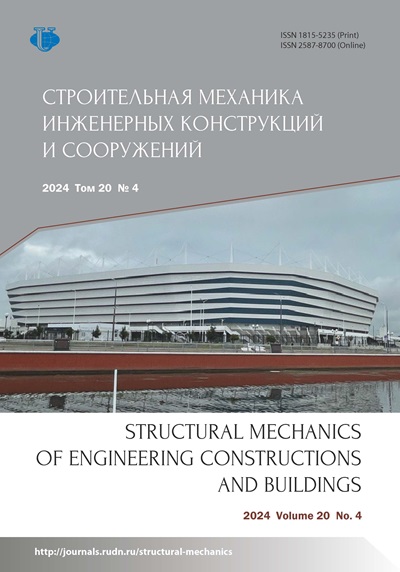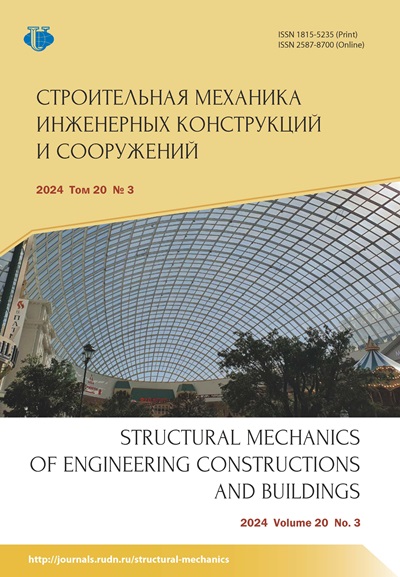Problems of Structural Dynamics with Negative Time
- Authors: Shtein A.V.1, Zylev V.B.1
-
Affiliations:
- Russian University of Transport
- Issue: Vol 20, No 3 (2024)
- Pages: 276-288
- Section: Dynamics of structures and buildings
- URL: https://journals.rudn.ru/structural-mechanics/article/view/40371
- DOI: https://doi.org/10.22363/1815-5235-2024-20-3-276-288
- EDN: https://elibrary.ru/KGHCLL
Cite item
Full Text
Abstract
A dynamic problem with negative flow of time is formulated. The conventional equations of motion with the addition of initial conditions are sufficient not only for the analysis of motion of a deformable system under the regular, forward flow of time, but they allow to restore the state of the system for past moments of time. The practical use of solving problems with negative time can be found primarily in testing numerical methods for integrating the equations of motion, since forward and backward algorithms are not identical. The proposed technique of testing numerical methods for solving dynamic problems can be applied virtually to any computational scheme of integrating the equations of motion. Two examples of numerical solution based on explicit computational scheme with Adams extrapolation are presented. The addressed problems deal with the plane deformation state of plates under large displacements. Plate regions are partitioned into triangular finite elements with uniform spacing for spatial meshing. The obtained curvilinear boundaries in this case are stepped. The results of the presented test cases demonstrated good accuracy of the tested method. Problems requiring a large number of integration steps (up to 1 million) were considered, and the system returned to the initial state with high accuracy. The second of the given numerical solutions had a computational scheme of 160 000 finite elements, and the dynamic solution of the problem has a pronounced wave-like behavior. In the examples, data on the recovery of elastic displacement, velocity and stress values are given. The main conclusion of the study is that the proposed technique of control of numerical methods can be effectively applied, especially for problems with wave-like solution properties.
About the authors
Alexey V. Shtein
Russian University of Transport
Email: avsh7714@yandex.ru
ORCID iD: 0009-0003-2232-5121
SPIN-code: 3150-4438
Associate Professor of the Department of Structural Mechanics
Moscow, RussiaVladimir B. Zylev
Russian University of Transport
Author for correspondence.
Email: zylevvb@ya.ru
ORCID iD: 0000-0001-5160-0389
Doctor of Technical Science, Head of the Department of Structural Mechanics
Moscow, RussiaReferences
- Karimi Y., Rashahmadi S., Hasanzadeh R. The effects of Newmark method parameters on errors in dynamic extended finite element method. International Journal of Engineering, Transactions A: Basics. 2018;31(1):50–57. https://doi.org/10.5829/ije.2018.31.01a.08
- Pasetto M., Waisman H., Chen J.S. A waweform relaxation Newmark method for structural dynamics problems. Computational Mechanics. 2019;63(6):1223–1242. https://doi.org/10.1007/s00466-018-1646-x
- Ma K., Du J., Liu Ya. Noninear dynamic behavior analysis of closed-loop self-excited crankshaft model using improved Newmark — β method. Nonlinear Dynamics. 2023;111(6):1223–1242. https://doi.org/10.1007/s11071-022-08100-3
- Ye Sh., Xue T., Zhang W. Multi-stage displacement analysis based on real-time dynamic slider method. Soil Dynamics and Earthquake Engineering. 2023;174(6):108209. https://doi.org/10.1016/j.soildyn.2023.1082
- Soltanieh G., Kabir M.Z., Shariyat M. Improvement of the dynamic instability of shallow hybrid composite cylindrical shells under impulse loads using shape memory alloy wires. Composites Part B: Engineering. 2019;167:167–179. https://doi.org/10.1016/j.compositesb.2018.12.040
- Bezhentseva M.V., Vutsin L.I., Kibets A.I., Krushka L. Finite element method for numerical modeling of elasticplastic deformation of wood under shock loading. Problems of strength and plasticity. 2020;82(4):428–441. (In Russ.) https://doi.org/10.32326/1814-9146-2020-82-4-428-441
- Bakushinsky A.B., Leonov A.S. Multifrequency inverse problem of scalar acoustics: remarks on nonuniqueness and solution algorithm. Journal of Mathematical Sciences. 2023;274(4):460–474. https://doi.org/10.1007/s10958-023- 06613-9
- Kasenov S., Askerbekova Ja., Tleulesova A. Algorithm construction based on the gradient method of one inverse problem for the acoustics equation. Eastern-European Journal of Enterprise Technologies. 2022;2(5):43–52. https://doi.org/10.15587/1729-4061.2022.253568
- Belai O.V., Podivilov E.V., Frumin L.L., Shapiro D.A. Inverse scattering problem for the wave equation in a onedimensional inhomogeneous medium. Optoelectronics, Instrumentation and Data Processing. 2009;45(6):546–553. https://doi.org/10.3103/S8756699009060090
- Symes W.W., Chen H., Minkoff S.E. Solution of an acoustic transmission inverse problem by extended inversion. Inverse Problems. 2022;38(11):115003. Available from: https://arxiv.org/pdf/2201.08891 (accessed: 10.12.2023).
- Zylev V.B., Shtein A.V. Numerical solution of the problem of nonlinear oscillations of a system of threads. Structural Mechanics and Analysis of Constructions. 1986;6:58–61. (In Russ.)
- Zylev V.B. Computational methods in nonlinear mechanics of structures. Moscow: NIC “Inzhener” Publ.; 1999. (In Russ.) ISBN 5-8208-0012-5
- Alexandrov A.V., Potapov V.D., Zylev V.B. Construction mechanics. In 2 books. Book 2. Dynamics and stability of elastic systems. Moscow: Vysshaya shkola Publ.; 2008. (In Russ.) ISBN: 9785060053579
- Zylev V.B., Grigoriev N.A., Alferov I.V. About the acceleration of points of elastic bodies in collisions. Structural Mechanics and Analysis of Constructions. 2019;2(283):59–61. (In Russ.) EDN: DJHVAE
















